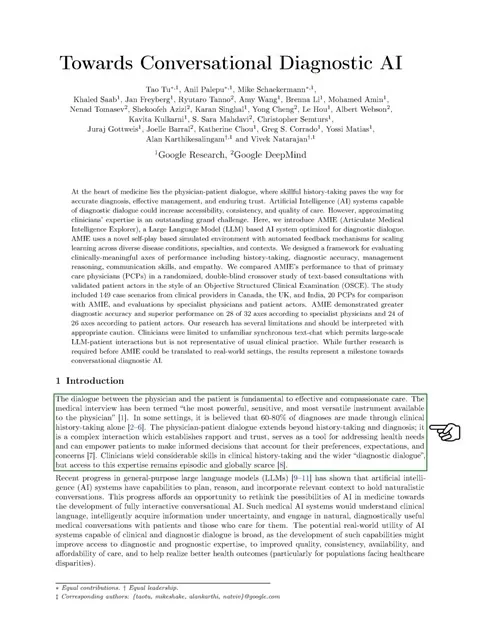Conversational AI's Diagnostic Potential in Healthcare Explored
The world of healthcare is being transformed by the rise of artificial intelligence (AI), and conversational AI is at the forefront of this revolution, particularly in diagnostic settings. By facilitating detailed history-taking and supporting accurate diagnoses, AI has the potential to significantly enhance patient care. This article explores the diagnostic capabilities of conversational AI, its advantages, current challenges, and future prospects, highlighting how it can improve the quality, consistency, and affordability of healthcare.
Key Points
- Conversational AI can improve diagnostic accuracy through effective history-taking.
- AI systems are showing promise in understanding clinical language and collecting data.
- Large Language Models (LLMs) can aid in planning, reasoning, and engaging in natural conversations.
- More research and evaluation are needed to understand the real-world applications of conversational AI in clinical settings.
- Ethical considerations and responsible AI deployment are essential.
The Promise of Conversational AI in Diagnostic Healthcare
Revolutionizing the Patient-Physician Dialogue
Effective diagnostic healthcare hinges on the patient-physician dialogue, which is crucial for understanding symptoms, medical history, and overall patient well-being. Skilled history-taking is essential for accurate diagnosis, effective management, and building trust. However, not everyone has access to such expertise.

This is where conversational AI steps in. With advancements in AI, especially Large Language Models (LLMs), we're seeing impressive capabilities in conducting natural, interactive conversations. These AI systems can plan, reason, and integrate relevant information to create meaningful medical interactions. This opens up exciting possibilities for AI in diagnostic healthcare, potentially improving the quality, consistency, and affordability of care. As these systems evolve, they could lead to better health outcomes, particularly for those facing healthcare disparities.
AI-Powered History Taking: A Deeper Dive
Conversational AI has the potential to enhance diagnostic accuracy by skillfully taking a patient's history. Up to 80% of diagnoses are made through conversations with patients, which not only aids in diagnosis but also builds trust and empowers patients to make informed decisions about their care. It's crucial to consider how AI systems approach patient interviews, focusing on:
- Diagnostic accuracy
- Appropriateness of management plans
- Building trust and fostering open communication with the patient
While LLMs have shown they can encode clinical knowledge and answer medical questions accurately, their conversational abilities in clinical settings are still largely unexplored. More research is needed to understand how AI systems can handle historical, history-taking, and diagnostic dialogues, as these are highly context-dependent. Evaluating the quality of a diagnostic dialogue requires multiple axes, including the structure and completeness of the information gathered.
The AMIE System: A Step Towards Conversational Diagnostic AI
Key Capabilities and Training
To address the gap in AI diagnostic capabilities, the Articulate Medical Intelligence Explorer (AMIE) system was developed. AMIE is an LLM-based conversational AI system designed for clinical history-taking and diagnostic dialogue. Its features include:

- A novel self-play-based simulated diagnostic dialogue environment with automated feedback to enhance and accelerate AMIE's learning process.
- An inference-time chain-of-reasoning strategy to improve diagnostic accuracy and conversational quality.
- A pilot evaluation rubric to assess AMIE's history-taking, diagnostic reasoning, communication skills, and empathy.
AMIE's capabilities were tested in a blinded remote OSCE study with 149 case scenarios from clinical providers in Canada, the US, and India, comparing AMIE to primary care physicians (PCPs). To enable AMIE's diagnostic reasoning, it was trained on real-world datasets, including multiple-choice medical questions, expert-curated long-form medical reasoning data, electronic health record (EHR) note summaries, and large-scale transcribed medical conversation interactions. AMIE was also trained to generate dialogues, answer medical questions, reason, and summarize.
AMIE's Performance: Accuracy and Efficiency
AMIE demonstrated greater diagnostic accuracy and superior performance compared to PCPs, particularly in answering questions related to patient factors. Its capabilities in diagnostic dialogue have shown it can accurately answer single-turn medical questions. AMIE's performance was compared to ground truth diagnoses and matched items on the accepted differential diagnosis list, proving its effectiveness across various specialties and scenarios.
Feature Benefit Diagnostic Capabilities Greater diagnostic accuracy, especially in certain areas. Reach Improves access to diagnostic expertise; vast potential. Quality and Consistency Enhances care quality and consistency. Cost-Effectiveness Potential to make healthcare more affordable. Health Outcome Potential The system could lead to better health outcomes, especially for those facing healthcare disparities.
Limitations and the Need for Further Research
Despite its impressive capabilities, AI-driven medical dialogues have limitations, such as the inability to consider non-verbal cues during examinations (telemedicine). It's crucial to evaluate AI systems across various perspectives and with broad datasets, focusing on:
- Structural quality
- Completeness of history gathered
- Accuracy of diagnosis
- Appropriateness of treatment plan
- Ability to build relationships with patients and communicate effectively
Future research should aim to leverage these technologies to identify and promote high-quality AI-generated clinical dialogues that offer both human connection and medical insight.
Unlocking the Power of Conversational AI: How to Use Diagnostic Tools
Steps for Clinical Integration
To integrate conversational AI like AMIE into clinical settings, consider the following steps:
- Assessing needs: Identify clinical areas that could benefit from AI-supported history-taking and diagnosis.
- Data privacy: Ensure compliance with data privacy regulations.
- Training and testing: Train clinicians on using AI tools and test to ensure proper use and improve AI effectiveness and reliability.
- Iterative feedback: Provide continuous feedback to improve existing AI systems for future applications.
- Oversight: Maintain human professional oversight to ensure both patients and AI tools are used in accordance with regulations.
Pricing and Availability of AI Diagnostic Tools
Factors Influencing Cost
The cost of conversational AI systems in diagnostic roles can vary significantly based on several factors:
- Development Costs: Developing sophisticated AI models requires substantial investment in research, data acquisition, and software engineering.
- Training: AI models are trained on massive amounts of medical data, which incurs costs for data refinement, organization, and cleaning.
- Maintenance and Updates: Clinical knowledge evolves, necessitating ongoing expenses for updates and upgrades.
- Deployment Model: AI tools can be deployed in the cloud or on devices, with devices incurring additional maintenance costs.
- Licensing: AI solutions may use proprietary elements, such as Speech-to-Text or other AI models, which can affect pricing.
As demand for AI in diagnostic roles grows and technologies evolve, we may see a wider range of affordable, secure, and effective AI tools.
Conversational AI for Diagnostics: Weighing the Benefits and Drawbacks
Pros
- Potential for improved diagnostic accuracy.
- Increased accessibility to medical information for patients.
- Streamlined workflows for healthcare professionals.
- Reduced costs through automated processes.
Cons
- Risk of inaccurate or biased diagnoses due to data limitations.
- Ethical issues surrounding data privacy and patient autonomy.
- Lack of emotional intelligence in communication.
Core Features of Conversational AI in Diagnostics
Essential Capabilities
Conversational AI systems in diagnostics rely on several core components to analyze and manage medical dialogue:
- Natural Language Processing (NLP): Analyzes text to gain insights into patient conditions.
- Medical Knowledge Base: Connects the system to extensive medical knowledge.
- Reasoning Engine: Infers patient conditions based on gathered information.
- Dialogue Management: Drives the flow of conversation, asking helpful questions and integrating responses.
- Self-Learning: Enhances the accuracy of the tool through constant use.
- Reporting and Integration: Provides a complete summary of interactions and integrates with existing systems.
Use Cases for Conversational AI in Diagnostic Settings
Applications in Healthcare
Conversational AI can streamline several key functions in diagnostic healthcare. Its applications include:
- Providing first-level diagnostic support.
- Augmenting primary care physicians.
- Streamlining follow-up patient management.
- Enhancing virtual care.
- Assisting with triaging during various medical conditions.
FAQ
What is conversational AI?
Conversational AI refers to technologies like chatbots and virtual assistants that can simulate human-like conversations. These systems use natural language processing (NLP) and machine learning to understand and respond to user inputs.
How can conversational AI assist with medical diagnosis?
In medical diagnosis, conversational AI can be used for initial patient screening, history-taking, and gathering relevant medical information. These systems can help healthcare providers collect data more efficiently, leading to more accurate diagnoses.
What are the benefits of conversational AI in healthcare?
Some of the benefits of conversational AI in healthcare include increased efficiency, improved patient access to care, reduced costs, and more accurate diagnoses.
What are the limitations of conversational AI in healthcare?
Some of the limitations of conversational AI in healthcare include the potential for bias, the need for human oversight, and the lack of emotional intelligence. Furthermore, they have not been tested for certain sensitivities or situations.
How is patient data protected when using conversational AI?
Conversational AI systems must comply with healthcare regulations like HIPAA to protect patient data. This involves implementing data encryption, access controls, and other security measures.
Related Questions
Will AI replace doctors?
AI is not positioned to completely replace doctors. Instead, AI has the potential to enhance their work with AI tools. By assisting with routine activities, AI enables specialists to focus on what only they can do—using knowledge and empathy. AI may improve patient care, but doctors can make unique contributions that extend beyond data.
Where is artificial intelligence going?
AI is rapidly evolving, and its impact is expected to continue growing. Machine learning, a component of AI, may enhance many areas. However, the lack of quality data has hindered AI implementation, though this is expected to change soon. Other challenges must be addressed, requiring insights from experts in relevant domains and ongoing discussions about societal implications.
Will new laws and regulations be adopted regarding AI systems and clinical dialogue?
As healthcare and technologies evolve, new regulations and medical standards are expected. The implementation of AI in diagnostic and other clinical roles will demand clarity regarding patient safety, privacy, security, and effectiveness. Therefore, it's crucial to address these considerations carefully and responsibly for all AI systems.
Related article
 AI-Powered Cover Letters: Expert Guide for Journal Submissions
In today's competitive academic publishing environment, crafting an effective cover letter can make the crucial difference in your manuscript's acceptance. Discover how AI-powered tools like ChatGPT can streamline this essential task, helping you cre
AI-Powered Cover Letters: Expert Guide for Journal Submissions
In today's competitive academic publishing environment, crafting an effective cover letter can make the crucial difference in your manuscript's acceptance. Discover how AI-powered tools like ChatGPT can streamline this essential task, helping you cre
 US to Sanction Foreign Officials Over Social Media Regulations
US Takes Stand Against Global Digital Content Regulations
The State Department issued a sharp diplomatic rebuke this week targeting European digital governance policies, signaling escalating tensions over control of online platforms. Secretary Marco
US to Sanction Foreign Officials Over Social Media Regulations
US Takes Stand Against Global Digital Content Regulations
The State Department issued a sharp diplomatic rebuke this week targeting European digital governance policies, signaling escalating tensions over control of online platforms. Secretary Marco
 Ultimate Guide to AI-Powered YouTube Video Summarizers
In our information-rich digital landscape, AI-powered YouTube video summarizers have become indispensable for efficient content consumption. This in-depth guide explores how to build a sophisticated summarization tool using cutting-edge NLP technolog
Comments (2)
0/200
Ultimate Guide to AI-Powered YouTube Video Summarizers
In our information-rich digital landscape, AI-powered YouTube video summarizers have become indispensable for efficient content consumption. This in-depth guide explores how to build a sophisticated summarization tool using cutting-edge NLP technolog
Comments (2)
0/200
![IsabellaLevis]() IsabellaLevis
IsabellaLevis
 September 6, 2025 at 2:30:41 AM EDT
September 6, 2025 at 2:30:41 AM EDT
医療AIの進化には驚かされますね😊 特に診断支援としての会話AIは医師の負担軽減に役立ちそう。でも、症状の微妙なニュアンスをAIがどこまで理解できるか気になります…誤診リスクは大丈夫かな?


 0
0
![SamuelAdams]() SamuelAdams
SamuelAdams
 July 27, 2025 at 9:19:05 PM EDT
July 27, 2025 at 9:19:05 PM EDT
Wow, conversational AI in healthcare sounds like a game-changer! Imagine chatting with a bot that nails your diagnosis faster than a doctor’s visit. But I wonder, will it ever catch those subtle human cues we rely on? 🤔


 0
0
The world of healthcare is being transformed by the rise of artificial intelligence (AI), and conversational AI is at the forefront of this revolution, particularly in diagnostic settings. By facilitating detailed history-taking and supporting accurate diagnoses, AI has the potential to significantly enhance patient care. This article explores the diagnostic capabilities of conversational AI, its advantages, current challenges, and future prospects, highlighting how it can improve the quality, consistency, and affordability of healthcare.
Key Points
- Conversational AI can improve diagnostic accuracy through effective history-taking.
- AI systems are showing promise in understanding clinical language and collecting data.
- Large Language Models (LLMs) can aid in planning, reasoning, and engaging in natural conversations.
- More research and evaluation are needed to understand the real-world applications of conversational AI in clinical settings.
- Ethical considerations and responsible AI deployment are essential.
The Promise of Conversational AI in Diagnostic Healthcare
Revolutionizing the Patient-Physician Dialogue
Effective diagnostic healthcare hinges on the patient-physician dialogue, which is crucial for understanding symptoms, medical history, and overall patient well-being. Skilled history-taking is essential for accurate diagnosis, effective management, and building trust. However, not everyone has access to such expertise.

This is where conversational AI steps in. With advancements in AI, especially Large Language Models (LLMs), we're seeing impressive capabilities in conducting natural, interactive conversations. These AI systems can plan, reason, and integrate relevant information to create meaningful medical interactions. This opens up exciting possibilities for AI in diagnostic healthcare, potentially improving the quality, consistency, and affordability of care. As these systems evolve, they could lead to better health outcomes, particularly for those facing healthcare disparities.
AI-Powered History Taking: A Deeper Dive
Conversational AI has the potential to enhance diagnostic accuracy by skillfully taking a patient's history. Up to 80% of diagnoses are made through conversations with patients, which not only aids in diagnosis but also builds trust and empowers patients to make informed decisions about their care. It's crucial to consider how AI systems approach patient interviews, focusing on:
- Diagnostic accuracy
- Appropriateness of management plans
- Building trust and fostering open communication with the patient
While LLMs have shown they can encode clinical knowledge and answer medical questions accurately, their conversational abilities in clinical settings are still largely unexplored. More research is needed to understand how AI systems can handle historical, history-taking, and diagnostic dialogues, as these are highly context-dependent. Evaluating the quality of a diagnostic dialogue requires multiple axes, including the structure and completeness of the information gathered.
The AMIE System: A Step Towards Conversational Diagnostic AI
Key Capabilities and Training
To address the gap in AI diagnostic capabilities, the Articulate Medical Intelligence Explorer (AMIE) system was developed. AMIE is an LLM-based conversational AI system designed for clinical history-taking and diagnostic dialogue. Its features include:

- A novel self-play-based simulated diagnostic dialogue environment with automated feedback to enhance and accelerate AMIE's learning process.
- An inference-time chain-of-reasoning strategy to improve diagnostic accuracy and conversational quality.
- A pilot evaluation rubric to assess AMIE's history-taking, diagnostic reasoning, communication skills, and empathy.
AMIE's capabilities were tested in a blinded remote OSCE study with 149 case scenarios from clinical providers in Canada, the US, and India, comparing AMIE to primary care physicians (PCPs). To enable AMIE's diagnostic reasoning, it was trained on real-world datasets, including multiple-choice medical questions, expert-curated long-form medical reasoning data, electronic health record (EHR) note summaries, and large-scale transcribed medical conversation interactions. AMIE was also trained to generate dialogues, answer medical questions, reason, and summarize.
AMIE's Performance: Accuracy and Efficiency
AMIE demonstrated greater diagnostic accuracy and superior performance compared to PCPs, particularly in answering questions related to patient factors. Its capabilities in diagnostic dialogue have shown it can accurately answer single-turn medical questions. AMIE's performance was compared to ground truth diagnoses and matched items on the accepted differential diagnosis list, proving its effectiveness across various specialties and scenarios.
| Feature | Benefit |
|---|---|
| Diagnostic Capabilities | Greater diagnostic accuracy, especially in certain areas. |
| Reach | Improves access to diagnostic expertise; vast potential. |
| Quality and Consistency | Enhances care quality and consistency. |
| Cost-Effectiveness | Potential to make healthcare more affordable. |
| Health Outcome Potential | The system could lead to better health outcomes, especially for those facing healthcare disparities. |
Limitations and the Need for Further Research
Despite its impressive capabilities, AI-driven medical dialogues have limitations, such as the inability to consider non-verbal cues during examinations (telemedicine). It's crucial to evaluate AI systems across various perspectives and with broad datasets, focusing on:
- Structural quality
- Completeness of history gathered
- Accuracy of diagnosis
- Appropriateness of treatment plan
- Ability to build relationships with patients and communicate effectively
Future research should aim to leverage these technologies to identify and promote high-quality AI-generated clinical dialogues that offer both human connection and medical insight.
Unlocking the Power of Conversational AI: How to Use Diagnostic Tools
Steps for Clinical Integration
To integrate conversational AI like AMIE into clinical settings, consider the following steps:
- Assessing needs: Identify clinical areas that could benefit from AI-supported history-taking and diagnosis.
- Data privacy: Ensure compliance with data privacy regulations.
- Training and testing: Train clinicians on using AI tools and test to ensure proper use and improve AI effectiveness and reliability.
- Iterative feedback: Provide continuous feedback to improve existing AI systems for future applications.
- Oversight: Maintain human professional oversight to ensure both patients and AI tools are used in accordance with regulations.
Pricing and Availability of AI Diagnostic Tools
Factors Influencing Cost
The cost of conversational AI systems in diagnostic roles can vary significantly based on several factors:
- Development Costs: Developing sophisticated AI models requires substantial investment in research, data acquisition, and software engineering.
- Training: AI models are trained on massive amounts of medical data, which incurs costs for data refinement, organization, and cleaning.
- Maintenance and Updates: Clinical knowledge evolves, necessitating ongoing expenses for updates and upgrades.
- Deployment Model: AI tools can be deployed in the cloud or on devices, with devices incurring additional maintenance costs.
- Licensing: AI solutions may use proprietary elements, such as Speech-to-Text or other AI models, which can affect pricing.
As demand for AI in diagnostic roles grows and technologies evolve, we may see a wider range of affordable, secure, and effective AI tools.
Conversational AI for Diagnostics: Weighing the Benefits and Drawbacks
Pros
- Potential for improved diagnostic accuracy.
- Increased accessibility to medical information for patients.
- Streamlined workflows for healthcare professionals.
- Reduced costs through automated processes.
Cons
- Risk of inaccurate or biased diagnoses due to data limitations.
- Ethical issues surrounding data privacy and patient autonomy.
- Lack of emotional intelligence in communication.
Core Features of Conversational AI in Diagnostics
Essential Capabilities
Conversational AI systems in diagnostics rely on several core components to analyze and manage medical dialogue:
- Natural Language Processing (NLP): Analyzes text to gain insights into patient conditions.
- Medical Knowledge Base: Connects the system to extensive medical knowledge.
- Reasoning Engine: Infers patient conditions based on gathered information.
- Dialogue Management: Drives the flow of conversation, asking helpful questions and integrating responses.
- Self-Learning: Enhances the accuracy of the tool through constant use.
- Reporting and Integration: Provides a complete summary of interactions and integrates with existing systems.
Use Cases for Conversational AI in Diagnostic Settings
Applications in Healthcare
Conversational AI can streamline several key functions in diagnostic healthcare. Its applications include:
- Providing first-level diagnostic support.
- Augmenting primary care physicians.
- Streamlining follow-up patient management.
- Enhancing virtual care.
- Assisting with triaging during various medical conditions.
FAQ
What is conversational AI?
Conversational AI refers to technologies like chatbots and virtual assistants that can simulate human-like conversations. These systems use natural language processing (NLP) and machine learning to understand and respond to user inputs.
How can conversational AI assist with medical diagnosis?
In medical diagnosis, conversational AI can be used for initial patient screening, history-taking, and gathering relevant medical information. These systems can help healthcare providers collect data more efficiently, leading to more accurate diagnoses.
What are the benefits of conversational AI in healthcare?
Some of the benefits of conversational AI in healthcare include increased efficiency, improved patient access to care, reduced costs, and more accurate diagnoses.
What are the limitations of conversational AI in healthcare?
Some of the limitations of conversational AI in healthcare include the potential for bias, the need for human oversight, and the lack of emotional intelligence. Furthermore, they have not been tested for certain sensitivities or situations.
How is patient data protected when using conversational AI?
Conversational AI systems must comply with healthcare regulations like HIPAA to protect patient data. This involves implementing data encryption, access controls, and other security measures.
Related Questions
Will AI replace doctors?
AI is not positioned to completely replace doctors. Instead, AI has the potential to enhance their work with AI tools. By assisting with routine activities, AI enables specialists to focus on what only they can do—using knowledge and empathy. AI may improve patient care, but doctors can make unique contributions that extend beyond data.
Where is artificial intelligence going?
AI is rapidly evolving, and its impact is expected to continue growing. Machine learning, a component of AI, may enhance many areas. However, the lack of quality data has hindered AI implementation, though this is expected to change soon. Other challenges must be addressed, requiring insights from experts in relevant domains and ongoing discussions about societal implications.
Will new laws and regulations be adopted regarding AI systems and clinical dialogue?
As healthcare and technologies evolve, new regulations and medical standards are expected. The implementation of AI in diagnostic and other clinical roles will demand clarity regarding patient safety, privacy, security, and effectiveness. Therefore, it's crucial to address these considerations carefully and responsibly for all AI systems.
 AI-Powered Cover Letters: Expert Guide for Journal Submissions
In today's competitive academic publishing environment, crafting an effective cover letter can make the crucial difference in your manuscript's acceptance. Discover how AI-powered tools like ChatGPT can streamline this essential task, helping you cre
AI-Powered Cover Letters: Expert Guide for Journal Submissions
In today's competitive academic publishing environment, crafting an effective cover letter can make the crucial difference in your manuscript's acceptance. Discover how AI-powered tools like ChatGPT can streamline this essential task, helping you cre
 US to Sanction Foreign Officials Over Social Media Regulations
US Takes Stand Against Global Digital Content Regulations
The State Department issued a sharp diplomatic rebuke this week targeting European digital governance policies, signaling escalating tensions over control of online platforms. Secretary Marco
US to Sanction Foreign Officials Over Social Media Regulations
US Takes Stand Against Global Digital Content Regulations
The State Department issued a sharp diplomatic rebuke this week targeting European digital governance policies, signaling escalating tensions over control of online platforms. Secretary Marco
 Ultimate Guide to AI-Powered YouTube Video Summarizers
In our information-rich digital landscape, AI-powered YouTube video summarizers have become indispensable for efficient content consumption. This in-depth guide explores how to build a sophisticated summarization tool using cutting-edge NLP technolog
Ultimate Guide to AI-Powered YouTube Video Summarizers
In our information-rich digital landscape, AI-powered YouTube video summarizers have become indispensable for efficient content consumption. This in-depth guide explores how to build a sophisticated summarization tool using cutting-edge NLP technolog
 September 6, 2025 at 2:30:41 AM EDT
September 6, 2025 at 2:30:41 AM EDT
医療AIの進化には驚かされますね😊 特に診断支援としての会話AIは医師の負担軽減に役立ちそう。でも、症状の微妙なニュアンスをAIがどこまで理解できるか気になります…誤診リスクは大丈夫かな?


 0
0
 July 27, 2025 at 9:19:05 PM EDT
July 27, 2025 at 9:19:05 PM EDT
Wow, conversational AI in healthcare sounds like a game-changer! Imagine chatting with a bot that nails your diagnosis faster than a doctor’s visit. But I wonder, will it ever catch those subtle human cues we rely on? 🤔


 0
0





























